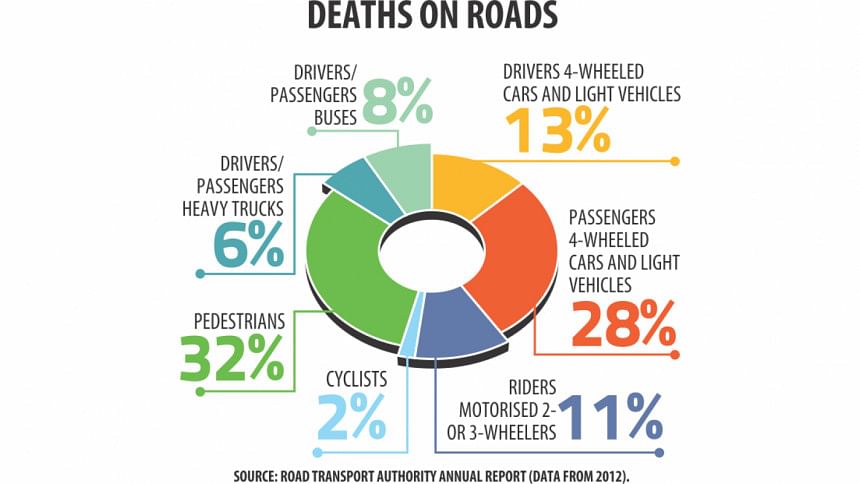Roads highly unsafe for pedestrians

Thirty-two percent of the people who die on the roads of Bangladesh every year are pedestrians, says a global report on road safety, exposing how deadly the roads are for pedestrians.
The pedestrian mortality rate is 10 percent higher than the global average, according to the Global Status Report on Road Safety 2015 released by the World Health Organisation (WHO) in Geneva yesterday.
The WHO's total deaths-on-roads figure for Bangladesh is 21,316 a year, much higher than the police claim of 2,538. The report included those who died of injuries sustained in road crashes. The police count includes those dead at the scenes.
The WHO report was prepared based on the information of 2012.
More pedestrians die in Bangladesh than many countries in the region.
Bhutan has the lowest death rate with three percent, Malaysia seven percent, India nine percent, Indonesia 21 percent, Thailand 23, Myanmar 26 percent and Sri Lanka 29 percent.
An expert, however, claimed that the figure of pedestrian deaths was much higher than what the WHO said. Hardly any facilities for walking and crossing roads were present in the country, said Prof Shamsul Hoque of Buet's civil engineering department.
He said 54 percent of the fatalities on the roads of Bangladesh were pedestrians, 70 percent of them were in the urban areas.
Experts say that the pedestrian fatality rate would climb higher as vehicles and population continue to rise in Bangladesh while significant road infrastructure and safety remained a far cry. They say that reckless driving, driving under the influence, using mobile phones while driving, and lack of enforcement of traffic laws were also to blame for the deaths on roads.
There were African and Latin American countries where pedestrian mortality rate was higher than that of Bangladesh, the WHO report said.
"Vulnerable road users, pedestrians, cyclists and motorcyclists, make up half of these fatalities," it says.
Low- and middle-income countries have double the fatality rate than that of the richer countries and they contribute 90 percent of the global deaths on roads.
It said the country loses an estimated 1.6 percent of its gross domestic product (GDP) due to road crashes that put a heavy burden on the national economies and on households.
"Many families are driven deeper into poverty by the loss of a breadwinner or by the expenses of prolonged medical care or the added burden of caring for a family member who is disabled from a road traffic injury," said the global report, adding that the economic costs also strike hard at a national level, imposing a significant burden on health, insurance and legal systems.
It reveals that 1.25 million people die each year on the world's roads and an estimated 3 percent of GDP is lost due to the deaths and injuries globally.
"Road traffic fatalities take an unacceptable toll -- particularly on poor people in poor countries," said Margaret Chan, director general of WHO, in a press release.
The report shows that road safety strategies were saving lives, "We're moving in the right direction," she said, "but it also tells us that the pace of change is too slow."
Even though 79 countries have seen a decrease in the absolute number of fatalities in the last three years, 68 countries have seen an increase.
Countries that have had the most success in reducing the number of road traffic deaths have achieved this by improving legislation, enforcement, and making roads and vehicles safer, the press release said.
African countries continue to have the highest road traffic death rates while the European countries the lowest.
Globally, road traffic crashes were a leading cause of death of young people.
Safe infrastructure and safe vehicles could help reduce road traffic injuries, said the report, adding that road infrastructure was mainly constructed with the needs of the motorists in mind, even though pedestrians, cyclists and motorcyclists account for 49 percent of all deaths on roads.
"Real, sustained successes at reducing global road traffic deaths will only happen when road design takes into consideration the needs of all road users," the report said.
While vehicles in high-income countries were increasingly safe, the report provides worrying data showing that less than half the countries implement minimum standards on vehicle safety.
Changing the road users' behaviour is a critical component of the holistic "Safe Systems" approach which could be done through enforcement of good laws, the report mentions.
"Decision-makers need to rethink transport policies," said Etienne Krug, director of WHO's Department for Management of Noncommunicable Diseases, Disability, Violence and Injury Prevention.
In 2010, the UN General Assembly adopted a resolution establishing the Decade of Action for Road Safety (2011–2020) with the goal to stabilise and reduce predicted levels of road traffic fatalities around the world.
The issue has also been included in the adopted Sustainable Development Goals with a target to halve traffic deaths and injuries by 2020.

 For all latest news, follow The Daily Star's Google News channel.
For all latest news, follow The Daily Star's Google News channel. 



Comments